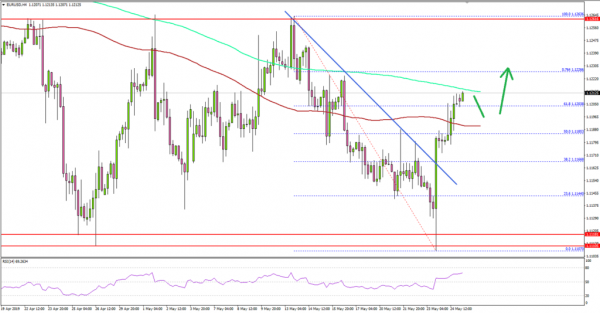Key Highlights
- The Euro found support near 1.1100 after a strong decline against the US Dollar.
- EUR/USD traded above a major bearish trend line at 1.1165 on the 4-hours chart.
- On the upside, there are many hurdles near 1.1225 and 1.1260.
- The US Durable Goods Orders in April 2019 declined 2.1%, more than the -2.0% forecast.
EURUSD Technical Analysis
This past week, the Euro declined below the 1.1150 and 1.1120 support levels against the US Dollar. The EUR/USD pair tested the 1.1100 support area and recently bounced back above 1.1150
Looking at the 4-hours chart, the pair spiked sharply after trading as low as 1.1107. It broke the 1.1165 resistance area and the 50% Fib retracement level of the downward move from the 1.1263 high to 1.1107 low.
Moreover, the pair traded above a major bearish trend line at 1.1165 on the same chart. It even climbed above the 100 simple moving average (red, 4-hours) and the 61.8% Fib retracement level of the downward move from the 1.1263 high to 1.1107 low.
However, there are many hurdles on the upside near the 1.1225 and 1.1250 levels. The main range resistance is near the 1.1265 area, where sellers are likely to defend more gains. If there is a successful break above the 1.1265 barrier, EUR/USD could climb further higher towards the 1.1300 level.
Conversely, if the pair fails to gain strength above 1.1250 or 1.1265, it could start a fresh decline. On the downside, an initial support is near the 1.1180 level, below which the pair is likely to test the 1.1150 support.
Fundamentally, the US Durable Goods Orders report for April 2019 was released by the US Census Bureau. The market was looking for a 2.0% decline in orders in April 2019.
The actual result was lower than the forecast, as there was a 2.1% decline in the US Durable Goods Orders. Moreover, the last reading was revised down from +2.7% to +1.7%.
The report added:
Excluding transportation, new orders were virtually unchanged. Excluding defense, new orders decreased 2.5 percent. Transportation equipment, also down two of the last three months, drove the decrease, $5.4 billion or 5.9 percent to $85.4 billion.
Overall, EUR/USD could move further higher, but other major pairs such as GBP/USD and USD/JPY might continue to struggle in the near term.













